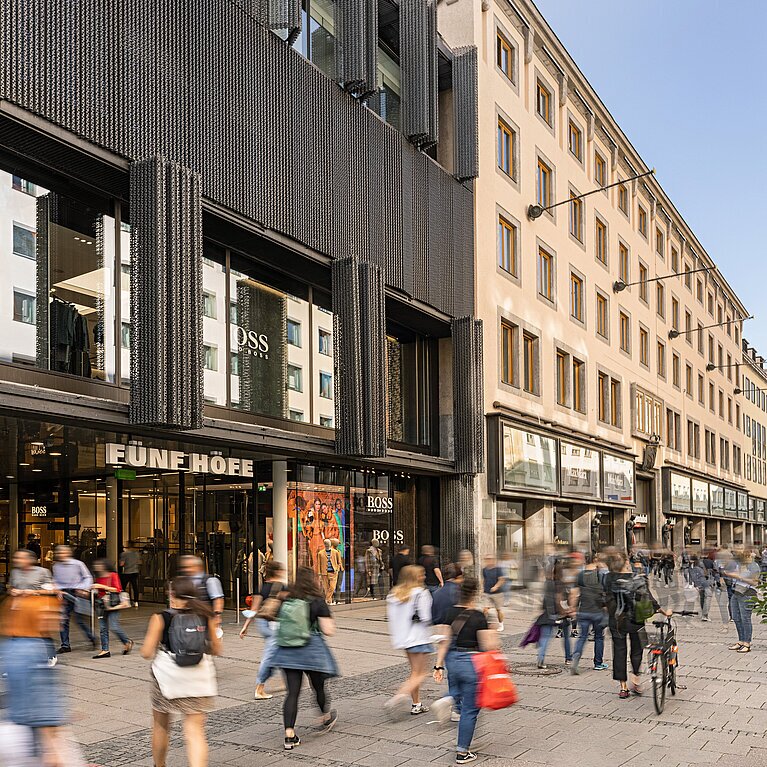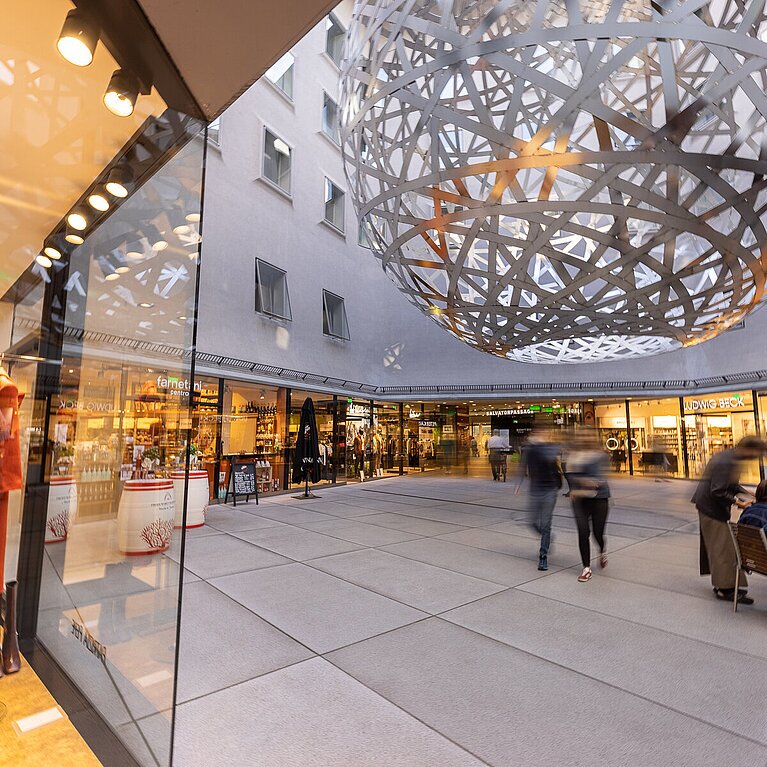


Owned by Union Investment and Hypo-Vereinsbank, the FÜNF HÖFE (Five Courts) are a unique and richly diverse ensemble at the heart of Munich. Katja Köpf, Center Manager FÜNF HÖFE, explains the unusual concept: “We’re not a classic shopping center; the name we prefer is CityQuartier, because this combination of architecture, art, retail, medical practices, offices and residential properties is pretty unique.” Could this be a blueprint for the city centers of the future? Even before its official opening in 2003, the quarter had already achieved a phenomenal pre-occupancy rate of 96 percent for its stores. Katja Köpf still prefers to sign ten-year contracts, “because we want to give our customers reliability. No pop-up stores, no overnight handovers. High customer loyalty is our bread and butter,” says the manager. And her concept of exclusive stores, design and specialist consulting is certainly successful.
Living and breathing variety
Amid today’s speculation about the future of the department store, amid huge vacancies looming within our cities, amid calls from retail experts for more events, personalized contact, special experiences and, of course, special restaurant and bar ideas, the FÜNF HÖFE has always led by example. Was it luck, or brilliant strategy? “Brilliant strategy, of course!” laughs Katja Köpf. “But luck always plays a role in how well the plan goes down with customers.” The majority of the 65 retailers and restaurant operators in the courts have been there for two decades, among them flagship stores of well-known companies that were eager to set up shop in Munich and specifically sought out the FÜNF HÖFE, but also bars and cafes that are unique to the quarter. The courts have their own characteristic charm. “We’re a community, and life here is like a big family where everybody knows everybody else,” enthuses Köpf. Size is also a significant factor in the success of the FÜNF HÖFE. Not too small, not too rambling, they first and foremost provide a colorful mix of stores on a single level. As Katja Köpf points out, nobody can get lost here. “No labyrinthine layout, no moving staircases. It’s all nice and clear.”

Experiencing design
The broadsheet daily Süddeutsche Zeitung coined the term “Glitzerkabinett” (glittering chamber) for the ensemble between Maffeistrasse and Theatinerstrasse. The quarter at the heart of the city does indeed glow, and not only at night. At a time when few had the foresight to predict the growth of competition from the expansion of the Internet and home delivery services, the FÜNF HÖFE was already showcasing the art of shopping. The array of stores combines minimalist design with opulence and magnificence in an atmosphere that changes at every step from courtyard to courtyard, arcade to arcade. Secluded Amirahof with its neat group of trees contrasts with vibrant, buzzy Viscardihof; narrow lanes give way to broad passages. Salvatorpassage, the green heart of the FÜNF HÖFE and almost 100 meters long, features natural hanging gardens that deftly capture a balance between above and below, nature and architecture, while spectators and strollers flock to Viscardihof, whose angled entrance entices them into the world of arcades that makes up the FÜNF HÖFE. The main pentagonal court is dominated by “Sphere,” a work by sculptor Ólafur Elíasson comprising a vast ten-ton ball woven from bands of stainless steel. Art is an intrinsic part of the FÜNF HÖFE. What other shopping mall can claim the same? The ensemble even incorporates the Kunsthalle, a bona fide exhibition gallery with themes that constantly tread the balance between insiders’ tip, major international attraction and blockbuster. Exclusivity is also a given at the FÜNF HÖFE. Katja Köpf runs down the list: “Multi-sensory shopping experience, personal attention and styling consultants in the stores, partnerships with nearby hotels, and lots and lots of service. That’s what sets us apart from online shopping.” Here too, it’s all about balance – and tone. “The more exceptional experiences I can design that people simply can’t imitate at home, the more customer loyalty I generate and the greater my customers’ appetite for more,” affirms the manager. “Here, I’m thinking of our regular open piano days and tango evenings, our program of events during Munich Film Festival, our partnership with the Bavarian State Opera – and even our selfie point with angel wings during the Christmas season!” The aim is always to spark a thrill. The city’s only private events plaza clearly knows exactly what is expected of it. Not forgetting the changing exhibitions at the internationally renowned Kunsthalle München, such as the current big-ticket show “Viktor& Rolf Fashion Statements.”

Basking in nature
The Hanging Gardens have become an iconic symbol of the FÜNF HÖFE. “Our lush plant-clad arcade immediately draws all eyes. The plants have such a powerful presence, and we constantly incorporate nature as an aspect of our events,” says Katja Köpf. These close ties became abundantly clear in the partnership between FÜNF HÖFE and the 2023 Munich-wide Flower Power Festival, initiated by the Kunsthalle with an exhibition entitled “Flowers Forever.” The connection extends through greened courtyards and roof terraces. “And there’s another special feature,” points out Katja Köpf: “Most malls and shopping centers are only accessible during store opening hours. Not us! From being a closed ensemble of bank premises 20 years ago, our passages are today open 24 / 7 and serve many Munich-dwellers as routes through the city as they go about their daily lives.” The mycelium-like web of passageways and courtyards has discreetly infiltrated the network of the city. And more and more people are using public transportation to get there – subways, light rail and buses. Katja Köpf admits, “Of course there are still people that don’t want to carry lots of bags around and come here by car, but the majority use public transport. Or they cycle in the summer.”
